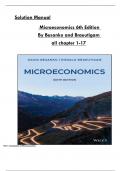Solution Manual
Microeconomics 6th Edition
By Besanko and Braeutigam
all chapter 1-17
Part 1: Introduction to Microeconomics
,Chapter 1. Analysing Economic Problems
Chapter 2. Demand and Supply Analysis
Part 2: Consumer Theory
Chapter 3. Consumer Preferences and the Concept of Utility
Chapter 4. Consumer Choice
Chapter 5. The Theory of Demand
Part 3: Production and Cost Theory
Chapter 6. Inputs and Production Functions
Chapter 7. Costs and Cost Minimisation
Chapter 8. Cost Curves
Part 4: Perfect Competition
Chapter 9. Perfectly Competitive Markets
Chapter 10. Competitive Marks: Applications
Part 5: Market Power
Chapter 11. Monopoly and Monopsony
Chapter 12. Capturing Surplus
Part 6: Imperfect Competition and Strategic Behaviour
Chapter 13. Market Structure and Competition
Chapter 14. Game Theory and Strategic Behaviours
Part 7: Special Topics
Chapter 15. Risk and Information
Chapter 16. General Equilibrium Theory
Chapter 17. Externalities and Public Goods
,Besanko & Braeutigam – Microeconomics, 5th edition Solutions Manual
Chapter 1
Analyzing Economic Problems
Solutions to Review Questions
1. What is the difference between microeconomics and macroeconomics?
Microeconomics studies the economic behavior of individual economic decision makers, such as
a consumer, a worker, a firm, or a manager. Macroeconomics studies how an entire national
economy performs, examining such topics as the aggregate levels of income and employment,
the levels of interest rates and prices, the rate of inflation, and the nature of business cycles.
2. Why is economics often described as the science of constrained choice?
While our wants for goods and services are unlimited, the resources necessary to produce those
goods and services, such as labor, managerial talent, capital, and raw materials, are “scarce”
because their supply is limited. This scarcity implies that we are constrained in the choices we
can make about which goods and services to produce. Thus, economics is often described as the
science of constrained choice.
3. How does the tool of constrained optimization help decision makers make choices?
What roles do the objective function and constraints play in a model of constrained
optimization?
Constrained optimization allows the decision maker to select the best (optimal) alternative while
accounting for any possible limitations or restrictions on the choices. The objective function
represents the relationship to be maximized or minimized. For example, a firm’s profit might be
the objective function and all choices will be evaluated in the profit function to determine which
yields the highest profit. The constraints place limitations on the choice the decision maker can
select and defines the set of alternatives from which the best will be chosen.
4. Suppose the market for wheat is competitive, with an upward-sloping supply curve,
a downward-sloping demand curve, and an equilibrium price of $4.00 per bushel. Why
would a higher price (e.g., $5.00 per bushel) not be an equilibrium price? Why would a
lower price (e.g., $2.50 per bushel) not be an equilibrium price?
If the price in the market was above the equilibrium price, consumers would be willing to
purchase fewer units than suppliers would be willing to sell, creating an excess supply. As
suppliers realize they are not selling the units they have made available, sellers will bid down the
Copyright © 2014 John Wiley & Sons, Inc. Chapter 1 - 1
, Chapter 1
Analyzing Economic Problems
Solutions to Review Questions
1. What is the difference between microeconomics and macroeconomics?
Microeconomics studies the economic behavior of individual economic decision makers, such as a
consumer, a worker, a firm, or a manager. Macroeconomics studies how an entire national
economy performs, examining such topics as the aggregate levels of income and employment, the
levels of interest rates and prices, the rate of inflation, and the nature of business cycles.
2. Why is economics often described as the science of constrained choice?
While our wants for goods and services are unlimited, the resources necessary to produce those
goods and services, such as labor, managerial talent, capital, and raw materials, are “scarce”
because their supply is limited. This scarcity implies that we are constrained in the choices we can
make about which goods and services to produce. Thus, economics is often described as the
science of constrained choice.
3. How does the tool of constrained optimization help decision makers make choices?
What roles do the objective function and constraints play in a model of constrained
optimization?
Constrained optimization allows the decision maker to select the best (optimal) alternative while
accounting for any possible limitations or restrictions on the choices. The objective function
represents the relationship to be maximized or minimized. For example, a firm‟s profit might be
the objective function and all choices will be evaluated in the profit function to determine which
yields the highest profit. The constraints place limitations on the choice the decision maker can
select and defines the set of alternatives from which the best will be chosen.
4. Suppose the market for wheat is competitive, with an upward-sloping supply curve,a
downward-sloping demand curve, and an equilibrium price of $4.00 per bushel. Why would
a higher price (e.g., $5.00 per bushel) not be an equilibrium price? Why would a lower price
(e.g., $2.50 per bushel) not be an equilibrium price?
If the price in the market was above the equilibrium price, consumers would be willing to
purchase fewer units than suppliers would be willing to sell, creating an excess supply. As




